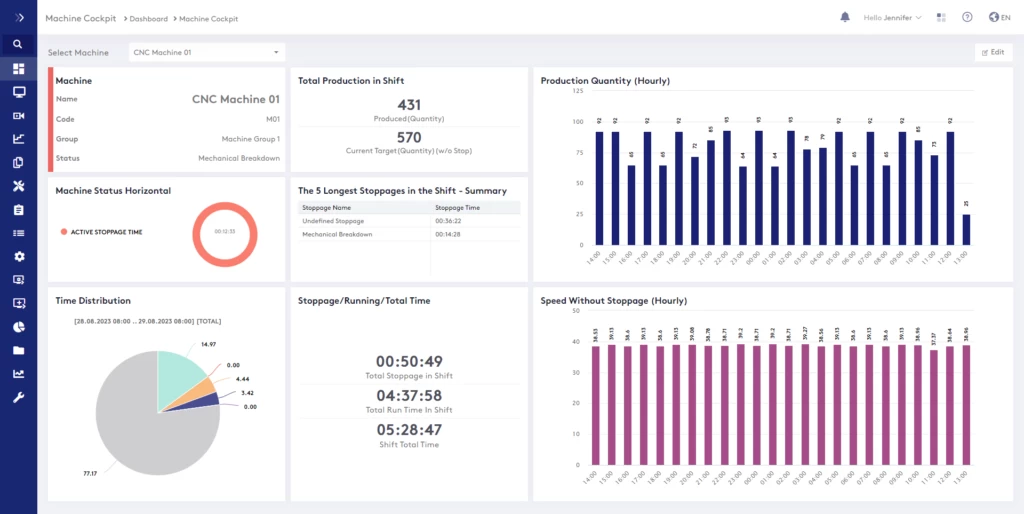We live in an age where consumers demand perfection and regulators enforce stringent standards. So, what does it mean for the manufacturers? Well, their manufacturing quality is non-negotiable. In fact, even minor defects can lead to costly recalls, reputational damage, and lost customer trust. And do you know what one thing can cause all this damage? Traditional quality control methods! After all, manual inspections, paper-based records, and reactive corrections are no longer sufficient to meet the growing demand and quality-control challenges. So, what is the solution to the advanced world we know?
We have a reliable solution in the form of Manufacturing Execution Systems (MES), a technological powerhouse that integrates quality management directly into production workflows. It enables real-time monitoring, automated inspections, and end-to-end traceability. In other words, MES transforms quality control from a cost center into a strategic asset.
The High Stakes of Quality Control in Modern Manufacturing
Quality defects are more than just operational hiccups; they shouldn’t be treated lightly. They’re existential risks that could ruin. For instance, a single faulty batch in pharmaceuticals can endanger lives. A mislabeled component in automotive manufacturing can trigger million-dollar recalls. Beyond financial penalties, poor quality can quickly erode brand loyalty and halt growth. Before you know it, the damage will be done to an irreparable extent. Yet, many manufacturers still rely on fragmented systems, with quality checks isolated from production processes. Even more shocking is that the inspections occur too late, and the root cause analysis takes a day to trace a defect’s origin – it is just unacceptable. Trust us when we say it feels more like searching for a needle in a haystack.
However, you won’t expect this from MES. After all, it can redefine quality control by embedding it into every stage of production. What’s more impressive is that MES doesn’t treat quality as a final checkpoint. Instead, MES makes it a continuous, data-driven process. By integrating sensors, machines, and human inputs, the system monitors critical parameters in real-time, flags deviations instantly, and provides actionable insights to prevent defects before they occur.
How MES Enhances Quality Control
Well, MES acts as a central hub for quality management, combining real-time data collection, automated workflows, and traceability tools. Here is what it does:
- Real-Time Quality Monitoring and Alerts
MES is not human, so it continuously tracks quality parameters such as temperature, pressure, dimensions, and chemical composition. It perfectly does that by using IoT sensors and machine data. For example, in food manufacturing, if a pasteurization machine deviates from the required temperature range, the system triggers an immediate alert. Supervisors can pause production, investigate the issue, and adjust settings before defective products accumulate. This proactive approach reduces waste and ensures only compliant items move downstream.

- Automated Inspections and Digital Work Instructions
We have been saying from time to time that manual inspections may seem like they are saving you money, but in reality, they are time-consuming and prone to human error. And with an MES system in place, you get an automated process that integrates with vision systems, laser scanners, and other inspection tools. In electronics manufacturing, automated optical inspection (AOI) systems connected to MES can detect soldering defects on circuit boards with micron-level precision. The system then updates digital work instructions to guide operators in reworking faulty units, ensuring consistency across batches.
- Root Cause Analysis and Corrective Actions
When defects occur (which it will for sure), MES accelerates problem-solving by correlating data across machines, materials, and processes. For instance, if a sudden spike in defective parts coincides with a new material batch, the system identifies the link and flags the supplier. If that happens, managers can implement corrective actions, such as adjusting machine settings or quarantining suspect materials, to prevent recurrence. This data-driven approach turns quality issues into opportunities for process refinement.
- Traceability: From Raw Materials to Finished Goods
It goes without saying that traceability is the backbone of modern quality control. And this is where MES truly shines. It creates a digital thread that tracks every component, machine, and operator involved in production. Each product receives a unique identifier (e.g., barcode or RFID tag), allowing manufacturers to trace its journey through the supply chain. In automotive manufacturing, for example, if a faulty brake component is discovered post-sale, MES can pinpoint which batches were affected, which machines produced them, and even which operators were on shift. This granular visibility minimizes recall scope, reduces liability, and accelerates resolution.

Quality as a Competitive Differentiator
We think we have established one thing by now: MES can truly transform quality control from a reactive burden into a proactive strategy. It is so important that manufacturers realize the importance of MES. After all, they can slash defect rates, ensure compliance, and turn quality into a marketable asset by simply marrying real-time monitoring with end-to-end traceability. The result would exceed expectations—fewer recalls, happier customers, and a reputation for excellence that drives sustainable growth.
Ultimately, we have to say that investing in MES isn’t just about fixing problems—it’s about preventing them altogether. If you want to pursue manufacturing excellence, your journey will be powered by data. Contact us today to learn more about how we can help you.

